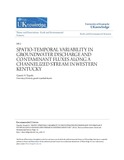Please use this identifier to cite or link to this item:
http://archive.nnl.gov.np:8080/handle/123456789/99| Title: | Spatio-temporal variability in groundwater discharge and contaminant fluxes along a channelized stream in Western Kentucky |
| Authors: | Tripathi, Ganesh Nath |
| Keywords: | Contaminant fluxes Trichloroethene Technetium-99 Baseflow Temperature probing |
| Issue Date: | 25-Feb-2018 |
| Abstract: | Surface and groundwater discharges and contaminant fluxes can vary with time and space depending upon the hydrogeological processes and geological setting of the area of interest. This study examined a ~300-m-long, channelized reach of a first-order perennial stream, Little Bayou Creek, in the Coastal Plain of far western Kentucky during the period October 2010–February 2012. Along the study reach, springs discharge groundwater contaminated by the chlorinated organic compound trichloroethene (TCE) and radionuclide technetium-99 (99Tc) released as a result of past activities at the U.S. Department of Energy’s Paducah Gaseous Diffusion Plant. The study addressed variability in groundwater discharge patterns and contaminant concentrations at various timescales (seasonal, annual, and decadal) and the extent to which the discharge sites are spatially persistent. Understanding patterns of groundwater discharge along a stream can be important for assessing the fate and transport of aqueous contaminants. Groundwater discharge was estimated during baseflow conditions using different massbalance approaches, including velocity-area and dye-dilution gauging. Discharge fluctuated seasonally but typically increased downstream, indicating the entire study reach to be gaining throughout the year. Discharge rates of individual springs also fluctuated seasonally. Tracer test data were utilized to model flow and transient storage along the reach using the USGS software OTIS-P. Cross-sectional area determined from OTIS-P was similar to that measured by velocity-area gauging. Reach area-normalized discharge fluxes were comparable to values determined by Darcy’s law calculations from a pair of monitoring wells at the downstream end of the study reach. Temperature data acquired from probing along grids in winter and summer, from fiber-optic sensing along the reach in autumn, and from data-loggers and manual measurements in springs were used to delineate focused discharge locations. Comparison of temperature-probing results with prior studies indicated that locations of some springs persisted over a decade, whereas other springs emerged and disappeared. Because the stream is located in unlithified sediments, discharge rates of springs appear to fluctuate with soil piping and collapse along joints in fractured clay. Contaminant concentrations in springs decreased downstream along the reach and were lower than observed during September 1999 – May 2001. The continued occurrence of dissolved oxygen and the absence of TCE daughter products in springs suggest that the decrease in TCE concentrations resulted from the installation of upgradient extraction wells, rather than from intrinsic reductive degradation. |
| Description: | A dissertation submitted in partial fulfillment of the requirements for the degree of Doctor of Philosophy in the College of Arts and Sciences at the University of Kentucky, 2013. |
| URI: | http://103.69.125.248:8080/xmlui/handle/123456789/99 |
| Appears in Collections: | 300 Social sciences |
Files in This Item:
| File | Description | Size | Format | |
|---|---|---|---|---|
| SPATIO-TEMPORAL VARIABILITY IN GROUNDWATER DISCHARGE AND CONTAMIN.pdf | 7.51 MB | Adobe PDF |  View/Open |
Items in DSpace are protected by copyright, with all rights reserved, unless otherwise indicated.